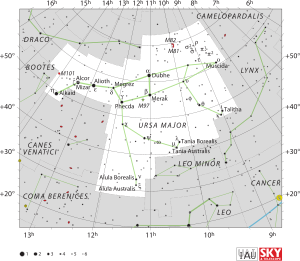Lalande 21185
| Observation data Epoch J2000.0 Equinox J2000.0 |
|
|---|---|
| Constellation | Ursa Major |
| Right ascension | 11h 03m 20.19400s |
| Declination | +35° 58′ 11.5682″ |
| Apparent magnitude (V) | 7.520 |
| Characteristics | |
| Spectral type | M2V |
| Apparent magnitude (B) | 8.960 ± 0.007 |
| Apparent magnitude (V) | 7.520 ± 0.009 |
| Apparent magnitude (R) | ~6.6 |
| Apparent magnitude (I) | ~5.8 |
| Apparent magnitude (J) | 4.203 ±0.242 |
| Apparent magnitude (H) | 3.640 ±0.202 |
| Apparent magnitude (K) | 3.254 ±0.306 |
| U−B color index | +1.074 |
| B−V color index | +1.444 |
| Variable type | BY |
| Astrometry | |
| Radial velocity (Rv) | −85.6 ± 1.0 km/s |
| Proper motion (μ) |
RA: −580.27 mas/yr Dec.: −4765.85 mas/yr |
| Parallax (π) | 392.64 ± 0.67mas |
| Distance | 8.31 ± 0.01 ly (2.547 ± 0.004 pc) |
| Absolute magnitude (MV) | 10.48 |
| Details | |
| Mass | 0.46 M☉ |
| Radius | 0.393 ± 0.008 R☉ |
| Luminosity (bolometric) | 0.021 L☉ |
| Luminosity (visual, LV) | 0.0055 L☉ |
| Surface gravity (log g) | 4.90 cgs |
| Temperature | 3,828 K |
| Metallicity [Fe/H] | −0.20 dex |
| Rotational velocity (v sin i) | 58 km/s |
| Age | 5–10 Gyr |
| Other designations | |
| Database references | |
| SIMBAD | data |
Lalande 21185 is a star in the constellation of Ursa Major, relevant for being the brightest red dwarf observable in the northern hemisphere (only AX Microscopii and Lacaille 9352, in the southern hemisphere, are brighter). Despite this, and although relatively close by, it is (as all red dwarves) very dim, being only magnitude 7.5 in visible light and thus too dim to be seen with the unaided eye. The star is visible through a small telescope or binoculars.
At approximately 8.31 light-years (2.55 parsecs) away it is one of the nearest stars to the Solar System; only the Alpha Centauri system, Barnard's Star, and Wolf 359 and the brown dwarfs Luhman 16 and WISE 0855−0714 are known to be closer. Because of its proximity it is a frequent subject for astronomical surveys and other research and thus is known by numerous other designations. Research papers most commonly use the designations BD+36 2147, Gliese 411, and HD 95735 to refer to this star. In approximately 19,900 years Lalande 21185 will be at its closest distance of about 4.65 ly (1.43 pc) from the Sun.
The celestial coordinates of Lalande 21185 were first published in 1801 by French astronomer Jérôme Lalande of the Paris Observatory in the star catalog Histoire Céleste Française. The catalog sequence numbers for majority of the observed stars, including this one, were introduced in its 1847 edition by Francis Baily. Today this star, along with a few others, is still commonly referred to by its Lalande catalog number.
...
Wikipedia

